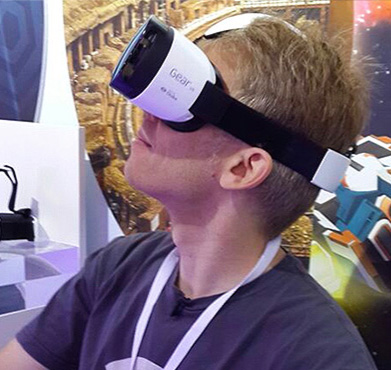It’s the dawning of exciting and ‘immersive’ new ways to engage the consumer and, to show how to add virtual reality (VR) to the marketing toolkit, this conference shared ideas and examples – and frightened the wits out of a visiting baby boomer.
Sitting on a sunny log surrounded by towering redwood trees, a dinosaur slumbers in front of me – just a couple of metres away. He wakes, gets to his feet, stretches high, catches my eye. Oh my.
I know I am not really his lunch, but still can’t quite quell the panic setting in; fight the urge for flight. As he comes up to me, inches from my face, then flips and flicks his vast tail at me, I flinch then laugh, displaying just a hint of hysteria. The chap who is in charge of the Samsung headset I am wearing (example pictured) steadies my arm to ground me; remind me. It is, of course, virtual reality. Fun. I am face to face with a flipping dinosaur for the hell of it.
Back to reality, other delegates at the recent VR Reality Bites conference sitting near me are either cleaning windows on the outside of a vast skyscraper or joy-riding a Jaguar around a virtual Andy Murray at Wimbledon. It’s all part of the experience this inaugural London conference offered – courtesy of events content agency Life Is Too Short and organiser Anne-Marie Sheedy. It was to show Virtual Reality ViRgins (VR – see what she did there?) how to add VR to the marketing toolkit. Top-level speakers were gathered to inform delegates how to harness this uber-new fun for their brands.
What can virtual reality do for your business?
Panel discussions ranged from Björk ’s 360 VR Icelandic and highly emotive video to theatre company Punchdrunk’s spectacle The Drowned Man. Where VR is being used effectively created most interest: current successful experiences include travel agents using VR to ‘show’ potential house buyers round the property; the Jaguar VR experience allowing test driving on a superbly memorable scale; travel agents taking holidaymakers around a tempting resort before they book in for real; a VR app from Samsung teaching the faint-hearted how to become better public speakers – complete with audience heckling, coughing, snoring – and scoring; there’s even a school bus with VR window views sharing an educational trip to Mars for the young passengers.
It’s the dawning of exciting and ‘immersive’ new ways to engage the consumer.
But Greg Furber, VR director at London-based agency REWIND advised delegates not to jump on the VR bandwagon without weighing up if it will truly fit their brand, warning: “The right content is crucial.” Panel colleague Ilicco Elia – head of mobile at DigitasLBi – agreed, succinctly adding: “Don’t lose your sh*t in the excitement of it! It’s an expensive channel, a completely new one, and it’s hard to grasp.”
Virtual reality in action for charity
One way it is working well is for charities looking to bring the plight of animals, disaster areas and terror attack victims face-to-face with those largely unaware in the public domain – to raise awareness, to connect people and make them think, feel and then (hopefully) donate.
For example, Unicef in New Zealand took the man in the street inside a Syrian refugee camp via a VR campaign that built empathy so well that one in six people who were approached donated their cash. Similarly, VR is being leveraged by Amnesty International workers who are taking the destruction in Aleppo to potential donors – they take a video one day and it is on the streets the next, giving people an immediate 360 degree view of the suffering.
Gabriel Hartnell – senior fundraising manager for WWF-UK – told delegates how VR has been making the plight of the tiger tangible. He said working the streets to engage with potential donors is the toughest part of his team’s job – particularly since there are 165,000 charities currently operating in the UK alone – and standing out from the crowd is challenging. “We are aiming to draw people in, tell the story. We set up our VR stand and want the queue to form – that is the holy grail of F2F marketing – to make the experience memorable.”
So is VR a fit for your brand? Can you put it to work for your business? Hartnell summed up: “If it makes sense, use it. But just because there’s a VR tool out there doesn’t mean you should use it.”
More VR Reality Bites events are planned by Sheedy’s team at Life Is Too Short. We’ll let you know when, meanwhile contact her via email: ams@lifeistooshort.london
A dragon, rather than a dinosaur, has drawn crowds from around the world to Belfast, as part of a tourism campaign promoting Northern Ireland as the home of Game of Thrones. More here.








Leave your thoughts